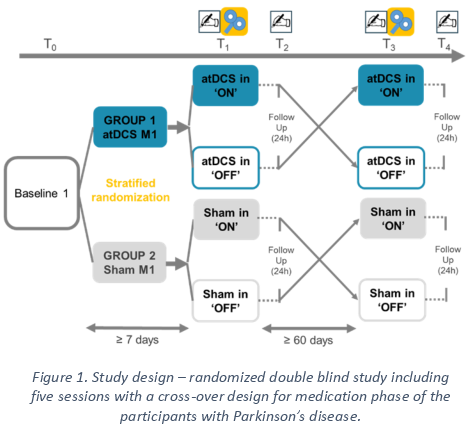Session Information
Date: Monday, September 23, 2019
Session Title: Physical and Occupational Therapy
Session Time: 1:45pm-3:15pm
Location: Les Muses Terrace, Level 3
Objective: To investigate effects of transcranial direct current stimulation (tDCS) concurrently applied with writing practice on consolidation of motor learning in Parkinson’s disease (PD) when ON and OFF medication. To examine the relationship between behavioral changes and cortical excitability.
Background: Learning of a habitual motor skill, such as writing, involves re-engagement of previously established motor programs affected by PD. Several studies show that motor learning interacts with medication. In PD, motor learning benefits are prone to interference and loss of retention and transfer, signifying consolidation deficits. Most tDCS studies in PD address motor performance and not learning, have small sample sizes and rarely study the neurophysiological mechanisms underlying tDCS. Our recent pilot work on 10 patients shows that tDCS can enhance consolidation of writing training.
Method: We are performing a randomized double-blind study including 40 PD patients, based on a power calculation using effect sizes from our previous work. All participants receive training on a tablet combined with 20 minutes of 1 mA anodal tDCS or sham over the left primary motor cortex. Writing is assessed during skill acquisition, pre- and post-training (T1) and after 24-hour retention (T2). The complete protocol is repeated (T3 and T4) in a different medication phase after a 2-month washout (Figure 1). Writing tests include: (i) trained and (ii) untrained sequences on a digitized tablet, (iii) writing on paper and (iv) writing during dual-tasking. Cortical excitability measured by a TMS protocol includes resting motor threshold (RMT), motor evoked potentials (MEP) and short-interval intracortical inhibition (SICI). The trial is registered as https://osf.io/gk5q8/.
Results: So far, 20 patients were recruited. All participants are right-handed with a mean age of 64.3 ± 8.5 years in Hoehn and Yahr stage 2.2 ± 0.6 and report to have writing problems. For 13 patients, the right side of the body is the most-affected side. Due to an adverse event after stimulation, 1 patient was excluded.
Conclusion: This study will make a forefront contribution to our knowledge on how tDCS, ON and OFF medication, may modify motor learning and cortical excitability. Together, these insights will determine the surplus value of incorporating non-invasive brain stimulation to boost the robustness of writing training in PD.
To cite this abstract in AMA style:
S. Broeder, T. Kramer, R. Meesen, G. Verheyden, JJ. Orban Dexivry, A. Nieuwboer. A Protocol to Test the Effects of TDCS on Consolidation of Writing Practice in Parkinson’s Disease [abstract]. Mov Disord. 2019; 34 (suppl 2). https://www.mdsabstracts.org/abstract/a-protocol-to-test-the-effects-of-tdcs-on-consolidation-of-writing-practice-in-parkinsons-disease/. Accessed September 12, 2025.« Back to 2019 International Congress
MDS Abstracts - https://www.mdsabstracts.org/abstract/a-protocol-to-test-the-effects-of-tdcs-on-consolidation-of-writing-practice-in-parkinsons-disease/

